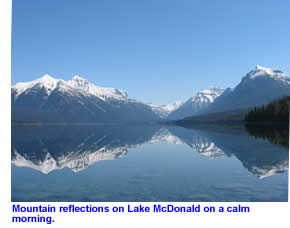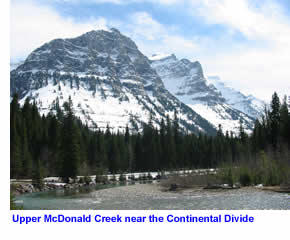Lake McDonald
.gif)
Lake McDonald is the largest lake in Glacier National Park. With a length
of 10 miles in length and more than a mile in width, Lake McDonald, which
lies in a giant bowl, is, surrounded by thickly forested, towering mountains.
On a calm day, which occurs fairly frequently in the mornings and evenings,
the mirrored reflection of the mountains in the lake provides a stunning
sight.
The lake itself, like many other lakes in Glacier National Park, was
created during the last ice age. During the last ice age ten thousand
years ago, massive glaciers with a height of more than 3000 feet slowly
crept down from the mountains, pushing a massive amount of dirt, rock
and other debris ahead of it (called a moraine) that often reached more
than 200 feet high. It also scoured a deep depression underneath its
path. As the ice age ended and the glaciers began to rapidly retreat,
a part of the glacier broke off. Trapped in the massive bowl that the
glacier itself created, the glacier melted, and, fed by additional inflows
from other melting glaciers, created Lake McDonald.
Lake McDonald receives most of its water from upper McDonald Creek.
This little creek, which can be a raging torrent during the height of
spring runoff, is fed entirely by snowmelt. As a result, the water is
crystal clear, very cold and has next to no nutrients.
The waters of Lake McDonald, not surprisingly, mirror those of McDonald
Creek. The water is exceptionally clear by any standard and is very cold-
and remains cold all summer long. At the head of Lake McDonald, McDonald
Creek flows out of the lake on a short but very beautiful journey to
the Middle
Fork of the Flathead River.
Lake McDonald is the most popular destination in Glacier National Park.
Several hotels and many other services are located at various points
on the lake, primarily at the head of the lake near the entrance to the
park at the town of West Glacier. That said, while it is developed, the
development in Glacier National Park is a far cry from the development
in other National Parks in the United States. Despite the development,
most of the shoreline of Lake McDonald consists of trees, with development
limited primarily to two areas.
Access to Lake McDonald is easy and excellent. The scenic and very popular
Going-to-the-Sun Road follows the lake closely on the south side. Numerous
parking areas are found all along the road. All one needs to do is hop
out of their car and take a short walk through the woods to reach the
lake. A boat ramp - rare for Glacier National Park - is also located
at the head of the lake in the village of Apgar.
For all of its scenic beauty and recreational opportunities, Lake McDonald
is sadly lacking in fishing quality. Years ago, Lake McDonald was a prime
place for catching huge bull trout. The introduction of lake trout and
other non-native species, however, sent the fishery into disarray. Today,
Lake McDonald has a healthy population of small cutthroat and rainbow
trout, a few large bull trout, and lots of lake trout - some of which
can get quite large.
Due to the poor fishing, Lake McDonald gets little fishing pressure.
The trout in the lake rise readily and greedily to pretty much any small
dry fly presented their way. The best time to fish for these gullible
trout is during the morning and evening hours, when the winds die down
and the lake can become as smooth as glass.
One would suspect that with its scenic beauty, Lake McDonald would get
a lot of use from motorboats and pleasure boats. However, somewhat surprisingly,
boating use on Lake McDonald is generally light to non-existent. While
some nice summer weekends can bring out the boaters from the nearby Flathead
Valley, generally the lake has few motorboats on it even during the summer
- although the lake can receive a fair amount of use from canoeists along
the shoreline near the village of Apgar.
Shore fishing for Lake McDonald trout is easily done. The lake is also
easy to wade in many sections, as gravel bars are commonly found along
the lakeshore. A boat is only really needed if an angler will be trolling
deep for lake trout or if they want to easily access the north shore
of the lake (which otherwise requires hiking in).
Overall, unless you are planning on fishing for lake trout, don't make
Lake McDonald a destination fishing spot. Instead, use it as a beautiful
place to fish in a stunning surrounding. Moreover, the gullible trout,
low fishing pressure and easy access make Lake McDonald an excellent
place to teach children how to fish.
Hiking Gear & Equipment Guide for Glacier National
Park |
 |
Rain
Jackets : Get
the right type of rain gear for Glacier Park |
Top of Page
|






